The Arc-based Plasma Lighting Market is estimated to be valued at USD 652.8 million in 2025 and is projected to reach USD 835.6 million by 2035, registering a compound annual growth rate (CAGR) of 2.5% over the forecast period. Such a restrained growth rate reflects the strong regulatory influences shaping the adoption of advanced lighting technologies. Environmental regulations targeting reduced energy consumption and extended product lifecycles play a central role in supporting the market, as plasma lighting systems are recognized for their efficiency and longevity. Competing technologies such as LEDs have benefitted from more favorable regulatory incentives, including subsidies and broader standardization, limiting the comparative growth of plasma-based solutions. The annual growth increments, rising from 652.8 million in 2025 to only 795.3 million by 2033, illustrate how regulatory emphasis on rapid energy transition channels greater support toward alternatives. Safety and compliance standards also influence adoption since plasma lighting requires specialized handling of high-intensity arcs. These compliance costs increase overall barriers to entry, restraining faster deployment. The sectors such as industrial facilities, large-scale horticulture, and infrastructure where regulatory standards prioritize intensity, durability, and reduced maintenance costs, create stable demand. The forecasted market progression suggests that regulatory influence ensures niche but consistent application rather than widespread dominance. The market trajectory is thus shaped more by compliance and selective incentives than by innovation-led acceleration.
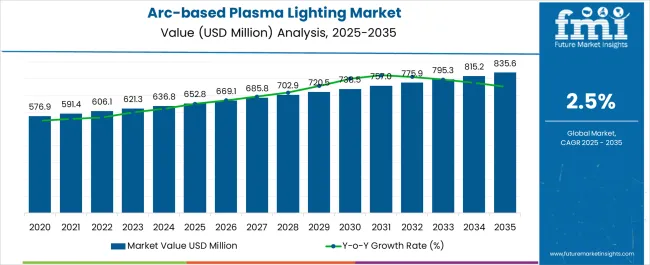
| Metric | Value |
|---|---|
| Arc-based Plasma Lighting Market Estimated Value in (2025 E) | USD 652.8 million |
| Arc-based Plasma Lighting Market Forecast Value in (2035 F) | USD 835.6 million |
| Forecast CAGR (2025 to 2035) | 2.5% |
The arc based plasma lighting market is expanding steadily due to increasing demand for high intensity illumination in specialized applications such as projection systems, medical equipment, and large venue lighting. These lighting solutions are valued for their high brightness, color rendering accuracy, and longer lifespan compared to conventional incandescent and halogen sources.
Industry stakeholders are leveraging these benefits to enhance energy efficiency and operational performance in environments that require focused and durable lighting. Technological innovations in lamp materials, thermal management, and miniaturization have further supported market penetration.
Moreover, environmental regulations encouraging the reduction of mercury-based lighting have positively influenced the adoption of xenon and other arc based plasma light sources. As sectors such as entertainment, industrial production, and scientific research increase demand for reliable high lumen output systems, the market is expected to maintain upward momentum.
The arc-based plasma lighting market is segmented by light source, wattage type, application, and geographic regions. By light source, the arc-based plasma lighting market is divided into Xenon arc lamps, Metal halide lamps, Deuterium lamps, Krypton arc lamps, and Mercury vapor lamps. In terms of wattage type, the arc-based plasma lighting market is classified into Below 500 W, 501 to 1,500 W, and Above 1,500 W. Based on application, the arc-based plasma lighting market is segmented into Entertainment & projection, Searchlight & spotlight, Solar simulation and environmental testing, Spectroscopy, Medical lighting, Microscopic lights, UV applications, and Others. Regionally, the arc-based plasma lighting industry is classified into North America, Latin America, Western Europe, Eastern Europe, Balkan & Baltic Countries, Russia & Belarus, Central Asia, East Asia, South Asia & Pacific, and the Middle East & Africa.
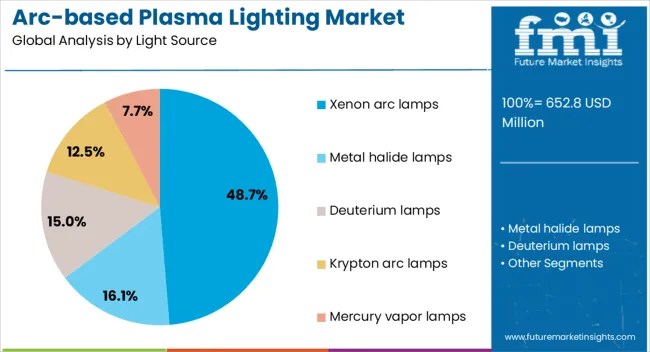
The xenon arc lamps segment is projected to hold 48.70% of total market revenue by 2025, positioning it as the most dominant light source in this category. This is primarily due to its ability to deliver intense white light that closely mimics natural daylight, making it ideal for use in high precision and visual performance applications.
These lamps are widely preferred for their stability, color temperature consistency, and high luminous efficacy. In industries such as projection, medical diagnostics, and film production, the superior light quality offered by xenon arc technology has strengthened its position.
In addition, reduced warm up time and extended service life have further supported their continued use in professional-grade lighting setups, reinforcing their leadership within the light source segment.
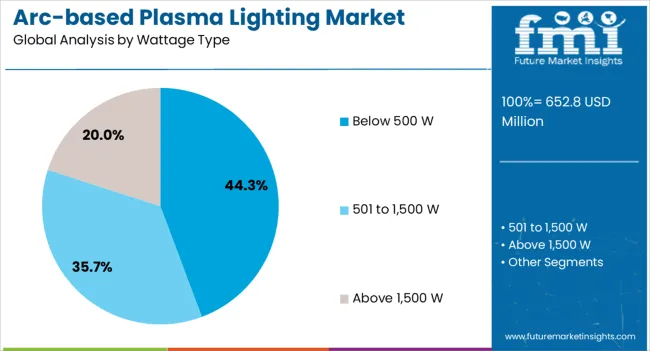
The below 500 W segment is expected to capture 44.30% of the overall market share by 2025 within the wattage type category. This prominence is attributed to its suitability for compact, energy efficient, and portable lighting systems used across commercial and professional settings.
Devices in this wattage range offer optimal performance while maintaining manageable heat output and energy consumption. The growing trend toward miniaturized and mobile projection systems, medical imaging tools, and entertainment lighting has increased demand for lower wattage configurations.
Additionally, their adaptability and compatibility with a range of projection and display technologies have solidified the segment’s dominance among users seeking efficient and reliable lighting solutions without excessive power requirements.
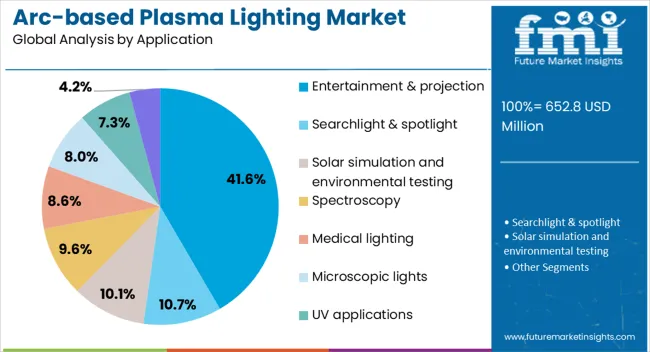
The entertainment and projection segment is projected to account for 41.60% of total market revenue by 2025, making it the leading application within the arc based plasma lighting industry. This growth is driven by the increasing use of high intensity lighting in cinema projectors, live event stages, and large scale displays where visual clarity and color accuracy are critical.
The reliability of arc-based plasma lighting in delivering consistent brightness and wide color spectrums enhances the visual experience in demanding projection environments. Furthermore, advancements in visual content delivery and audience engagement technologies have further elevated the importance of quality lighting.
As a result, the entertainment and projection industry continues to adopt xenon and other plasma light sources at scale, reinforcing this segment's leadership in application-driven demand.
The market has been expanding as advanced lighting technologies are deployed across industrial, horticultural, and large-scale infrastructure applications. This technology has been recognized for its high-intensity illumination, superior lifespan, and energy efficiency compared with traditional high-intensity discharge lamps. Its ability to provide full-spectrum light has supported adoption in specialized applications, particularly in plant growth systems and sports arenas. The demand has been reinforced by energy-saving initiatives, the push for sustainable lighting, and advancements in plasma ignition and control systems.
Arc-based plasma lighting has been increasingly adopted due to its superior efficiency and extended operational lifespan compared with conventional lighting technologies. These lamps have been designed to provide consistent illumination while consuming less energy, thereby reducing overall operational costs. Their lifespan has been observed to exceed 50,000 hours in many installations, minimizing replacement frequency and maintenance expenses. High luminous efficacy and reduced lumen depreciation have positioned these lights as viable options for industrial, horticultural, and outdoor applications. Moreover, reduced environmental impact, owing to lower energy consumption and minimal hazardous material usage, has made this technology favorable among industries seeking reliable and efficient lighting solutions.
The adoption of arc-based plasma lighting has been significantly influenced by its effectiveness in horticulture and controlled environment agriculture. These systems have been able to deliver full-spectrum lighting that closely mimics natural sunlight, supporting plant photosynthesis and growth across different cycles. Their use has been reported in vertical farms, greenhouses, and research facilities, where crop yield and quality improvements have been prioritized. Unlike conventional artificial lights, plasma lamps have produced a balanced spectrum, including UV and infrared components, which benefit plant morphology. This has enabled growers to reduce dependency on chemical growth stimulators, further lowering input costs. As demand for reliable agricultural lighting solutions increases, arc-based plasma lighting has been recognized as a suitable alternative to LEDs in specialized cultivation setups.
The market has been shaped by its growing use in industrial and large-scale infrastructure projects. High lumen output and uniform light distribution have made plasma lamps suitable for warehouses, manufacturing plants, roadways, tunnels, and sports arenas. Their ability to operate in challenging environments with minimal degradation has further supported adoption. Reduced warm-up time and flicker-free performance have enhanced operational reliability, while integration with smart lighting controls has enabled efficient energy management. In addition, their resilience to voltage fluctuations has allowed deployment in regions with unstable power supply. This durability, combined with superior illumination performance, has positioned plasma lighting as an effective alternative to traditional discharge lamps and even LEDs in certain high-intensity lighting environments.
Despite their advantages, arc-based plasma lighting has been facing competitive pressures from the rapid adoption of LED technology. LEDs have dominated the market due to declining costs, compact designs, and integration with advanced digital control systems. Although plasma lighting offers superior spectral qualities and long operational life, its higher upfront cost and limited manufacturer base have constrained wider adoption. Furthermore, research and development investment in LEDs has outpaced plasma lighting, reinforcing the dominance of LED-based solutions in general-purpose and specialized applications. However, arc-based plasma lights have continued to retain a niche presence in applications where spectral quality and high-intensity illumination are critical, such as horticulture and large-scale outdoor infrastructure. This has created both challenges and opportunities for manufacturers in differentiating their product positioning.
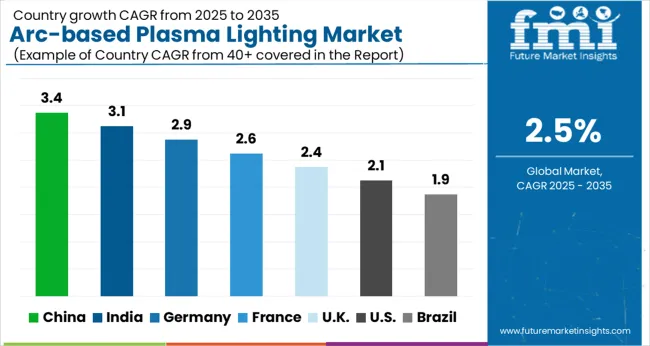
| Countries | CAGR |
|---|---|
| China | 3.4% |
| India | 3.1% |
| Germany | 2.9% |
| France | 2.6% |
| UK | 2.4% |
| USA | 2.1% |
| Brazil | 1.9% |
The market is projected to grow at a CAGR of 2.5% from 2025 to 2035, supported by niche demand in high-intensity industrial, horticultural, and specialty commercial applications. China leads with a 3.4% CAGR, driven by strong manufacturing capacity and infrastructure usage. India follows at 3.1%, deploying solutions for energy-efficient industrial and agricultural lighting. Germany, at 2.9%, advances through precision engineering and performance-focused projects. The UK, growing at 2.4%, adopts plasma lighting in controlled-environment agriculture and specialized urban installations. The USA, at 2.1%, sees steady uptake across research, entertainment, and select commercial settings. This report includes insights on 40+ countries; the top markets are shown here for reference.
China is projected to lead the market with a CAGR of 3.4%. Industrial facilities, outdoor lighting projects, and sports arenas are key demand contributors. Focus on energy efficiency and high-intensity illumination is driving adoption. Government initiatives to replace conventional lighting systems with advanced alternatives are influencing investment patterns. Manufacturers are enhancing plasma lighting systems with longer operational lifespans, reduced maintenance costs, and better lumen performance. Collaborations with infrastructure developers and stadium projects are further shaping growth in this segment.
India’s market is expected to grow at a CAGR of 3.1%, fueled by expanding urban infrastructure, large-scale industrial facilities, and transportation hubs. Energy-efficient lighting solutions are being prioritized in high-capacity areas where conventional lighting is less effective. Manufacturers are promoting plasma lighting solutions due to their durability and reduced energy consumption. Government-driven projects in transportation and public infrastructure are expected to enhance adoption. Partnerships between lighting companies and contractors for large-scale installations are expanding the market scope.

Germany is forecasted to expand at a CAGR of 2.9%, driven by industrial lighting, sports complexes, and outdoor illumination projects. Rising demand for sustainable and energy-efficient lighting systems is reshaping adoption trends. Manufacturers are integrating smart control systems to optimize energy consumption and operational efficiency. Stringent European regulations promoting efficient lighting solutions are influencing product innovation. The shift from conventional discharge lamps to advanced plasma lighting in industrial environments continues to gain momentum.
The United Kingdom market is projected to grow at a CAGR of 2.4%, with demand emerging from transportation hubs, sports infrastructure, and industrial facilities. Manufacturers are offering solutions with extended lifespan and reduced operating costs. Emphasis on energy savings and compliance with efficiency regulations is strengthening adoption. Collaborations with local authorities and contractors are ensuring market expansion in public infrastructure projects. Adoption is also rising in large-scale event facilities where high-intensity illumination is required.
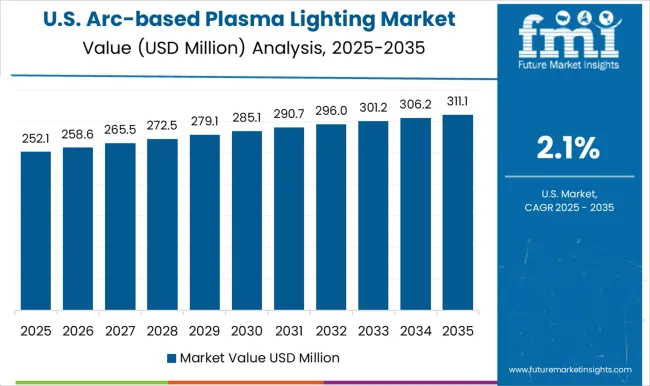
The United States market is forecasted to grow at a CAGR of 2.1%, supported by industrial operations, sports arenas, and outdoor facilities requiring high-intensity lighting. Manufacturers are focusing on improving lumen output, energy efficiency, and system durability. Investments in infrastructure modernization are influencing adoption. Collaborations with construction companies, stadium developers, and municipal authorities are supporting deployment. The market is also shaped by gradual replacement of conventional high-intensity discharge lamps with plasma-based systems.
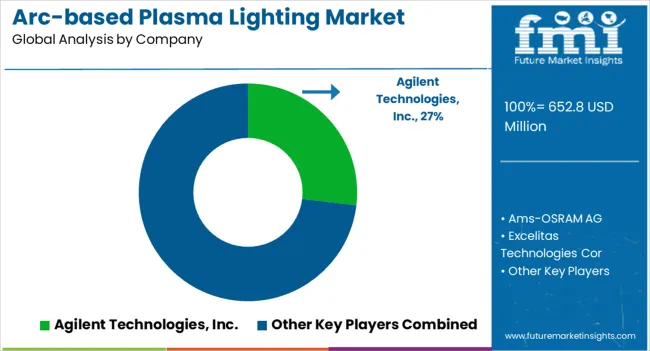
The market is gaining importance as industries seek high-intensity, efficient, and long-lasting illumination solutions. Agilent Technologies, Inc. and Ams-OSRAM AG have established strong positions with advanced optical and semiconductor lighting technologies that serve both industrial and research applications. Excelitas Technologies Corp. provides specialized systems designed for demanding environments requiring durability and precision, while Hamamatsu Photonics K.K. is recognized for its contributions in photonics research and industrial illumination. LEDVANCE GmbH focuses on energy-efficient plasma lighting solutions that support cost control and large-scale usage, making it a competitive choice across multiple sectors. Signify Holding plays an influential role by combining plasma lighting technologies with smart and automated lighting systems that improve energy performance and operational efficiency. Ushio Inc. remains an essential provider with its broad expertise in specialty lighting, particularly in healthcare, entertainment, and industrial applications. Collectively, these companies enhance market competitiveness by investing in innovation, developing adaptable product ranges, and leveraging global distribution. Market growth is increasingly being shaped by rising demand for efficient lighting technologies that reduce operational costs and extend service life. As end users prioritize sustainability and performance reliability, the focus remains on refining plasma lighting solutions that ensure consistent illumination and operational benefits across specialized industries.
| Item | Value |
|---|---|
| Quantitative Units | USD 652.8 Million |
| Light Source | Xenon arc lamps, Metal halide lamps, Deuterium lamps, Krypton arc lamps, and Mercury vapor lamps |
| Wattage Type | Below 500 W, 501 to 1,500 W, and Above 1,500 W |
| Application | Entertainment & projection, Searchlight & spotlight, Solar simulation and environmental testing, Spectroscopy, Medical lighting, Microscopic lights, UV applications, and Others |
| Regions Covered | North America, Europe, Asia-Pacific, Latin America, Middle East & Africa |
| Country Covered | United States, Canada, Germany, France, United Kingdom, China, Japan, India, Brazil, South Africa |
| Key Companies Profiled | Agilent Technologies, Inc., Ams-OSRAM AG, Excelitas Technologies Cor, Hamamatsu Photonics K.K., LEDVANCE GmbH, Signify Holding, and Ushio Inc. |
| Additional Attributes | Dollar sales by lighting type and application, demand dynamics across industrial, commercial, and entertainment sectors, regional trends in advanced lighting adoption, innovation in energy efficiency and brightness control, environmental impact of energy consumption and disposal, and emerging use cases in horticulture and large-scale event illumination. |
The global arc-based plasma lighting market is estimated to be valued at USD 652.8 million in 2025.
The market size for the arc-based plasma lighting market is projected to reach USD 835.6 million by 2035.
The arc-based plasma lighting market is expected to grow at a 2.5% CAGR between 2025 and 2035.
The key product types in arc-based plasma lighting market are xenon arc lamps, metal halide lamps, deuterium lamps, krypton arc lamps and mercury vapor lamps.
In terms of wattage type, below 500 w segment to command 44.3% share in the arc-based plasma lighting market in 2025.






Our Research Products

The "Full Research Suite" delivers actionable market intel, deep dives on markets or technologies, so clients act faster, cut risk, and unlock growth.

The Leaderboard benchmarks and ranks top vendors, classifying them as Established Leaders, Leading Challengers, or Disruptors & Challengers.

Locates where complements amplify value and substitutes erode it, forecasting net impact by horizon

We deliver granular, decision-grade intel: market sizing, 5-year forecasts, pricing, adoption, usage, revenue, and operational KPIs—plus competitor tracking, regulation, and value chains—across 60 countries broadly.

Spot the shifts before they hit your P&L. We track inflection points, adoption curves, pricing moves, and ecosystem plays to show where demand is heading, why it is changing, and what to do next across high-growth markets and disruptive tech

Real-time reads of user behavior. We track shifting priorities, perceptions of today’s and next-gen services, and provider experience, then pace how fast tech moves from trial to adoption, blending buyer, consumer, and channel inputs with social signals (#WhySwitch, #UX).

Partner with our analyst team to build a custom report designed around your business priorities. From analysing market trends to assessing competitors or crafting bespoke datasets, we tailor insights to your needs.
Supplier Intelligence
Discovery & Profiling
Capacity & Footprint
Performance & Risk
Compliance & Governance
Commercial Readiness
Who Supplies Whom
Scorecards & Shortlists
Playbooks & Docs
Category Intelligence
Definition & Scope
Demand & Use Cases
Cost Drivers
Market Structure
Supply Chain Map
Trade & Policy
Operating Norms
Deliverables
Buyer Intelligence
Account Basics
Spend & Scope
Procurement Model
Vendor Requirements
Terms & Policies
Entry Strategy
Pain Points & Triggers
Outputs
Pricing Analysis
Benchmarks
Trends
Should-Cost
Indexation
Landed Cost
Commercial Terms
Deliverables
Brand Analysis
Positioning & Value Prop
Share & Presence
Customer Evidence
Go-to-Market
Digital & Reputation
Compliance & Trust
KPIs & Gaps
Outputs
Full Research Suite comprises of:
Market outlook & trends analysis
Interviews & case studies
Strategic recommendations
Vendor profiles & capabilities analysis
5-year forecasts
8 regions and 60+ country-level data splits
Market segment data splits
12 months of continuous data updates
DELIVERED AS:
PDF EXCEL ONLINE
Plasma Lighting Market
Plasma Dynamic Air Sterilizer Market Size and Share Forecast Outlook 2025 to 2035
Lighting As A Service Market Size and Share Forecast Outlook 2025 to 2035
Plasma Cutting Machine Market Size and Share Forecast Outlook 2025 to 2035
Lighting as a Service (LaaS) Market Size and Share Forecast Outlook 2025 to 2035
Lighting Product Market Size and Share Forecast Outlook 2025 to 2035
Plasma Bottle Market Size and Share Forecast Outlook 2025 to 2035
Plasma Powder Market Size and Share Forecast Outlook 2025 to 2035
Plasma Separation Tubes Market Trends – Demand & Forecast 2025 to 2035
Competitive Overview of Plasma Bottle Industry Share
Lighting Contactor Market Growth – Trends & Forecast 2024-2034
Plasma-Derived Drugs Market
Plasma Protein System Market
Plasma-derived Protein Therapies Market
Lighting Fixture Market
EV Lighting Market Growth - Trends & Forecast 2025 to 2035
RF Plasma Generators Market
CNC Plasma Cutting Machines Market Size and Share Forecast Outlook 2025 to 2035
Mycoplasma Plate Antigens Market Size and Share Forecast Outlook 2025 to 2035
LED Lighting Controllers Market

Thank you!
You will receive an email from our Business Development Manager. Please be sure to check your SPAM/JUNK folder too.
Chat With
MaRIA